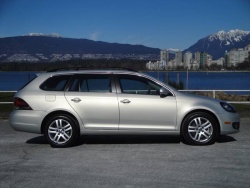 2011 Volkswagen Golf wagon. Click image to enlarge |
| Related articles on Autos.ca Volkswagen Golf TDI Manufacturer’s web site |
Review and photos by Greg Wilson
Photo Gallery:
2011 Volkswagen Golf wagon
As the only diesel-powered compact wagon available in Canada, the VW Golf wagon TDI offers a rare combination of outstanding fuel economy, generous cargo capacity, and everyday driveability at a price starting under $30,000. The fact that this alternative fuel wagon was voted Best New Family Car in the 2010 AJAC Canadian Car of the Year Awards, and the VW Jetta TDI sedan was voted Best New Family Car in 2011, says a lot about how good today’s diesel engine technology has become.
It’s amazing, really, that Volkswagen is still the only automaker in Canada offering diesel engines in vehicles priced under $30,000. Sure, you can get a diesel engine in a $50,000 BMW 335d or a $70,000 Mercedes-Benz E-Class or a $50,000 Dodge pickup, but where are the affordable diesel cars? Now that we have ultra-low sulphur diesel fuel, and cleaner, quieter and more powerful diesel engines, past objections to diesel engines no longer apply. Even so, vehicle manufacturers are reluctant to offer diesels in Canada. The first generation Smart Fortwo model had a small diesel engine, but it was discontinued in the second generation car in favour of a small gas engine, primarily because Smart’s surveys showed that American buyers didn’t want diesels – so we didn’t get one either. Apparently, Canada is just too small a market to justify a Canada-only diesel car.
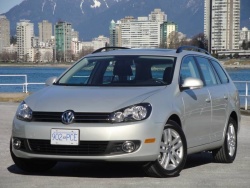 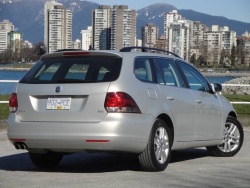 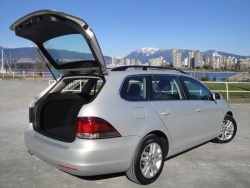 2011 Volkswagen Golf wagon. Click image to enlarge |
However, Volkswagen should still get a lot of credit for continuing to offer affordable diesel cars in North America at all, since no one else will. The Golf hatchback, Golf wagon, Jetta sedan, and the upcoming 2012 Passat sedan all offer optional diesels. In the U.S., the Golf wagon is called the Jetta Sportwagen (with an ‘e’ like Volkswagen), but it’s basically the same car.
The subject of this road test is a 2011 Golf wagon TDI in the mid-range Comfortline trim level. Interestingly, while Golf Wagons with the standard 2.5-litre gasoline engine are offered in base Trendline ($22,975) and mid-level Comfortline ($24,075) trim, the Golf wagon TDI comes only in mid-level Comfortline ($26,875) and top-of-the-line Highline ($30,775) trim. Among other things, that means that you can get leather seats and optional navigation in the TDI Wagon (Highline) but not in the gas model (Comfortline).
Our 2011 Golf wagon Comfortline TDI test model has a base price of $26,875. It’s well equipped with such features as 16-inch all-season tires and alloy wheels, front fog lights, chrome trim around the windows and grille, remote central door locking, air conditioning, height-adjustable front seats with lumbar adjusters and seat heaters, CD player and eight speakers, leather-wrapped steering wheel, shift knob and hand brake, split folding rear seatbacks with centre pass-through and cargo cover.
Our test car was equipped with all the options that could be added to the Comfortline trim level: a six-speed DSG automatic transmission with Tiptronic manual mode ($1,400), “Panoramic” power sunroof ($1,780); Multimedia Package that includes a “Premium 8” AM/FM radio with touch-screen, 6-disc CD changer, and Sirius Satellite radio; iPod connector, Bluetooth hands-free phone setup, multifunction steering wheel, trip computer, and digital compass ($1,300); and rear side airbags ($450), for a total of $4,930 in options.
With a $1,365 Freight and PDI charge and $100 air conditioning tax, the as-tested price came to $33,270 (not including taxes).
Since the main reason people buy the Golf wagon instead of the Golf hatchback is the extra cargo space, let’s start with the cargo area. As the Golf wagon is about 355 mm (14 in.) longer than a Golf hatchback, it adds a considerable amount of cargo space. With the rear seats up, the Golf wagon has more than twice the amount of luggage space: 930 litres (32.8 cu. ft.) vs 410 litres (14.6 cu. ft.). With both rear seatbacks folded down, the wagon offers 1,890 litres (67 cu. ft.) vs 1,300 litres (45.9 cu. ft.) in the Golf hatchback.
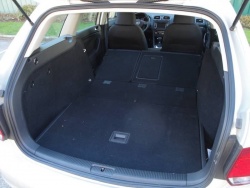 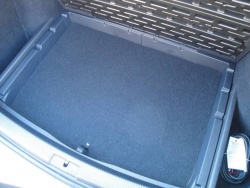 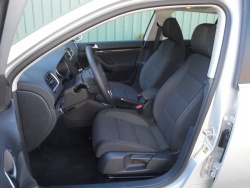 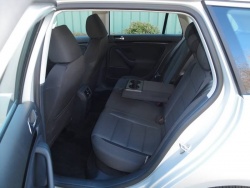 2011 Volkswagen Golf wagon. Click image to enlarge |
The wagon’s rear hatch lifts up to reveal a large cargo opening that’s 78 cm (31 in.) tall by 110 cm (43 in.) wide, however the width of cargo is restricted by the width between the wheelhouses of 99 cm (39 in.). The length of the cargo floor to the back of the rear seats is 101 cm (40 in.), and when the rear seatbacks are folded down, floor length increases to 177 cm (70 in.) Unlike some wagons, the front passenger seatback does not fold flat.
The cargo area has a fully carpeted floor, walls and rear seatbacks – only the inside of the rear cargo door has a plastic surface. The cargo lip has a plastic shield to prevent damage to cargo when loading but will probably get scratched itself. Upper and lower tie-down hooks can be used to secure cargo. Two open bins behind the rear wheelwells are handy for keeping washer fluid bottles and tools from sliding around the trunk, and under the floor is a large but shallow hidden storage bin. A sliding privacy cover keeps valuables out of sight, and when removed, allows an extra foot of vertical storage space.
Standard 60/40 split folding seatbacks allow up to two people to ride in the rear seat while one side is folded down for lengthy cargo. As well, a centre pass-through is great for skis and poles. My only criticism about these seats is that they don’t fold down perfectly flat – they are slightly inclined. However, they’re easier to use than the previous Golf’s seats which required the cushion to be pulled up and the head restraints to be removed before folding down the seatback.
The Golf’s passenger cabin is roomy enough for four adults, or five in a squeeze. There’s plenty of headroom for everybody and generous leg, knee and footroom front and rear. Rear passengers have a fold-down centre armrest with two cupholders, magazine pockets on the back of the front seats, door storage pocket, a centre storage bin, and rear air vents.
Both front occupants have height adjustable bucket seats with a manual lever on the side of the cushion, and combined with a standard tilt/telescopic steering, drivers of all sizes should find a comfortable driving position. One criticism: the reclining seatbacks use a European-style dial at the base of the seat that’s awkward to reach and turn.
Both front seats come with seat heaters that offer three temperature choices, a feature that I appreciated just about every day in February. The standard fabric seat material is of a superior quality to that seen in many of its competitors, and the front seats offers a good combination of comfort and support. Front passengers also have padded door armrests and a padded centre armrest.
Golf wagon Comfortline TDI models come with a standard leather-wrapped, three-spoke steering wheel, leather shift knob and leather parking brake handle which all add a measure of class to the interior. Other quality-enhancing trim features include aluminum around the shift lever, metal trim around the gauges, air vents, radio and heater control, metal trim on the steering wheel, and a thin strip of faux carbon-fibre-like trim on the dash and doors.
Our test car had the optional $1,300 Multimedia Package that includes a “Premium 8” AM/FM radio with touch-screen, 6-disc CD changer, and Sirius Satellite radio. The large colour touch-screen is used for audio and screen display settings, but not for climate control (or navigation functions). It’s easy to use with big illuminated “buttons” but some functions, such as radio station Seek, require at least two steps to activate whereas a simple Seek button on the radio face would have been easier.
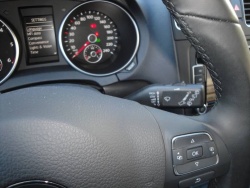 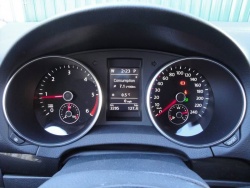 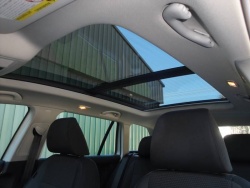 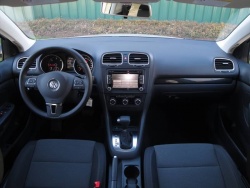 2011 Volkswagen Golf wagon. Click image to enlarge |
Unlike Ford’s Sync system, VW doesn’t offer a voice-activated audio system, however, the Multimedia Package does include a voice-activated Bluetooth cell phone system which can be initiated using a button on the steering wheel. Inside the centre armrest is an iPod connector and a slot to place your iPod or music player. There’s also an auxiliary jack on the outside of the centre console, and a 12-volt powerpoint in a small bin in front of the shift lever.
Also part of the optional Multimedia Package is a trip computer that displays information on the small screen between the speedometer and tachometer. The driver can scroll through different information options using the buttons on the right steering wheel spoke, and these include average and current fuel consumption, range, average speed, travel time, compass, outside temperature display, and various settings for lights and displays.
Considering all the features offered in the $1,300 Multimedia Package, it seems like a very good value to us.
Another option our car had was the Panoramic sunroof: this consists of front and rear glass roof panels, and a power sliding sunshade. The front glass panel tilts and slides back like a normal sunroof and includes a wind deflector, while the rear glass panel is fixed in place. When the sunshade is fully retracted, it allows plenty of natural light to illuminate both the front and rear seating areas, giving a more open feeling to the cabin, and a view of the sky. It’s a bit pricey though at $1,780.
While VW’s standard “Climatic single zone climate control” sounds like automatic climate control, it includes manual temperature control, manual fan speed, manual vent selection, and manual air conditioning button. Air conditioning is standard.
For front occupants, storage space for odds and ends is limited to the glovebox and door pockets – the centre storage box between the front seats is only big enough for an iPod and a small camera. Another small gripe: the two cupholders between the front seats have no cup grippers.
All Golf Wagons come with standard front, front-side, and overhead curtain airbags. Optional rear side airbags in our test car ($450) provide extra protection for rear adult occupants in a side collision, but I’m not sure of the safety implications for children in outboard car seats.
When it comes to performance, the generous low-end torque (236 lb.-ft. at 1,750 – 2,500 rpm) of Volkswagen’s turbocharged 140-hp 2.0-litre four-cylinder diesel TDI engine provides excellent throttle responsiveness in the 0 to 50 km/h range, and the ability to cruise at very low revs and climb mild grades without gearing down. While its 0 to 100 km/h time of 10.2 seconds (AJAC) may not be quick, its perky around-town performance, leisurely cruising ability, and excellent fuel economy makes up for it. And besides, it’s a utility wagon, not a sports car!
Contributing to its zippy low-speed acceleration and good fuel economy is the Golf’s optional six-speed Direct Shift Gearbox (which always pre-selects the next gear for quicker shift times). It enhances the engine’s performance with shift points timed for quick acceleration, rapid shift times, and leisurely top-end engine speeds when cruising on the highway – the tach reads just 1,800 r.p.m. at 100 km/h. It also shifts down automatically when descending a hill for engine braking. While driving around town, the engine likes to spend most of its time below 2,000 rpm which not only contributes to good fuel economy, but also to quiet running. In fact, it’s only when idling with the windows down, that the clatter of the diesel engine is really noticeable.
The DSG tranny includes a “Sport” mode which delays upshifts and quickens downshifts for higher revs, better performance, and more aggressive engine braking. However, this also increases fuel consumption, and is probably an unnecessary feature in a car like this.
Drivers have the option to shift the DSG manually in a sequential fashion without a clutch pedal: the shift lever is moved into a separate gate on the right, and pushed forwards to shift up and back to shift down. It’s easy and quick, but the Golf TDI doesn’t have paddles shifters behind the wheel like the GTI.
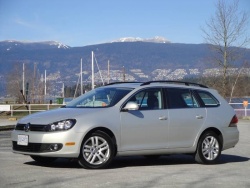 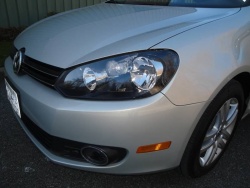 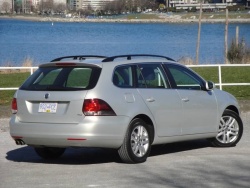 2011 Volkswagen Golf wagon. Click image to enlarge |
For those who prefer a traditional manual transmission, the Golf TDI is available with a standard six-speed manual transmission.
Fuel consumption, when equipped with the DSG transmission (as published by the Environmental Protection Agency in the U.S. which uses more realistic testing methods than Canada’s Energuide), is 8.1 L/100 km city, and 6.0 L/100 km highway with a combined rating of 7.1 L/100 km. Equipped with the manual transmission, the EPA rating is even better: 7.8/5.6 city/hwy, or 6.9 combined. During our week with the DSG-equipped car, we averaged 7.1 L/100 km in a 50/50 mix of city/highway driving. But if you do a lot of highway driving, you can lower this by at least one litre per 100 kms.
For comparison, a Golf wagon with the 2.5-litre five-cylinder gas engine gets 9.8/7.6 city/hwy with the automatic transmission. Perhaps the only competitor with better fuel economy is the Toyota Prius Hybrid which offers an outstanding 4.6/4.7 city/hwy. Even more competitive will be the new Prius Hybrid wagon which will be joining Toyota’s line-up later this year. However, the Prius is a completely different driving experience for a number of reasons, and we don’t really see much cross shopping there.
Unlike the new VW Jetta sedan which switched to a semi-independent torsion beam rear suspension, the Golf wagon still has a fully independent multi-link rear suspension which contributes to more car control over bumpy surfaces. The Golf wagon is not as nimble or as light as the Golf Hatchback (it’s 102 kg heavier), but it still handles with confidence and feels well-planted when cornering hard. We found the Wagon’s ride comfortable but firm and the body felt tight. My test car had Bridgestone Turanza 205/55R-16 inch all-season tires which proved quiet and grippy in the wet conditions we experienced. Consumer Reports says of this tire: “A very good choice for three-season driving, if tread life is not a high priority.” Standard electronic stability control is there to mitigate loss of directional control in slippery situations.
The Golf wagon’s standard electromechanical rack and pinion steering requires a medium steering effort which might be a bit stiff for some people when parking, but its turning diameter of 10.9 metres (35.8 ft.) is reasonably tight, and the Golf Wagon tracks well at high speeds.
Braking chores are handled by four discs with ABS. AJAC’s braking tests show a braking distance of 43 metres (141 ft.) from 100 km/h in the dry, neither outstanding nor shameful in this class.
Overall, we liked the Golf wagon TDI’s everyday driveability, interior roominess, and fuel efficiency, but we wish VW would offer a base model in the $25,000 range. As a compact car, it would be nice to see a model that could be bought for under $30,000, all in.
|
Pricing: 2011 Volkswagen Golf wagon TDI Comfortline
Specifications
Competitors
Crash test results
|











